- Qualcomm Launches Snapdragon 4 Gen 2 Mobile Platform
- AMD Launches Ryzen PRO 7000 Series Mobile & Desktop Platform
- Intel Launches Sleek Single-Slot Arc Pro A60 Workstation Graphics Card
- NVIDIA Announces Latest Ada Lovelace Additions: GeForce RTX 4060 Ti & RTX 4060
- Maxon Redshift With AMD Radeon GPU Rendering Support Now Available
Intel Core i7 – Choosing the Best Memory Kit
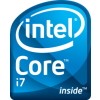
Can’t decide on the right memory kit to pick up with your brand-new Core i7 PC upon release? This article was designed for you. We aren’t comparing brands here, but are rather comparing densities and frequencies against each other to see if there’s any point at all in purchasing a higher-end kit. You might just be surprised at our results.
Page 2 – Test System & Methodology, Benchmarks
At Techgage, we strive to make sure our results are as accurate as possible. Our testing is rigorous and time-consuming, but we feel the effort is worth it. In an attempt to leave no question unanswered, this page contains not only our testbed specifications, but also a fully-detailed look at how we conduct our testing.
If there is a bit of information that we’ve omitted, or you wish to offer thoughts or suggest changes, please feel free to shoot us an e-mail or post in our forums.
Test System
The table below lists the hardware for our two current machines, which remains unchanged throughout all testing, with the exception of the processor. Each CPU used for the sake of comparison is also listed here, along with the BIOS version of the motherboard used. In addition, each one of the URLs in this table can be clicked to view the respective review of that product, or if a review doesn’t exist, you will be led to the product on the manufacturer’s website.
|
Component
|
Core i7 Test System
|
| Processor |
Intel Core i7 Extreme 965 – Quad-Core, 3.20GHz, 1.30v
|
| Motherboard |
ASUS P6T Deluxe – X58-based, 2624 BIOS (10/23/08)
|
| Memory |
DDR3: Qimonda 3x1GB – DDR3-1066 7-7-7-20-1T, 1.56v
DDR3: OCZ 3x2GB – Gold DDR3-1600 8-8-8-24-1T, 1.65v |
| Graphics |
Palit Radeon HD 4870 512MB (Catalyst 8.9)
|
| Audio |
On-Board Audio
|
| Storage | |
| Power Supply | |
| Chassis | |
| Display | |
| Cooling | |
| Et cetera |
When preparing our testbeds for any type of performance testing, we follow these guidelines:
- General Guidelines
- No power-saving options are enabled in the motherboard’s BIOS.
- Internet is disabled.
- No Virus Scanner or Firewall is installed.
- The OS is kept clean; no scrap files are left in between runs.
- Hard drives affected are defragged with Diskeeper 2008 prior to a fresh benchmarking run.
- Machine has proper airflow and the room temperature is 80°F (27°C) or less.
- Windows Vista Optimizations
- User Account Control (UAC) and screen saver are disabled.
- Windows Defender, Firewall, Security Center, Search, Sidebar and Updates are disabled.
Memory Configurations
Because the ultimate goal of this article is to see how much of a real-world difference faster memory avails, we are running a total of five different configurations, four being with our OCZ 6GB kit. We vary the speeds from the very low-end speed of DDR3-800 to the high-end speed of DDR3-1600. We should note that DDR3-800 speeds are not going to be common amongst triple-channel kits, but we’ve included results to showcase the differences nonetheless.
- RAM Configurations
- OCZ Gold – 3x2GB – DDR3-800 6-6-6-15-1T, 1.60v
- Qimonda – 3x1GB – DDR3-1066 7-7-7-20-1T, 1.65v
- OCZ Gold – 3x2GB – DDR3-1066 7-7-7-20-1T, 1.65v
- OCZ Gold – 3x2GB – DDR3-1333 7-7-7-20-1T, 1.65v
- OCZ Gold – 3x2GB – DDR3-1600 8-8-8-24-1T, 1.65v
Most of the same benchmarks we used in our Core i7 preview article return here, with the exception of our two games. To take the place of the games, we use 3DMark Vantage, which is more than intense enough to show us where a bottleneck may lie. For detailed explanations on the tests themselves, please refer to our Core i7 preview.
With that all said, let’s jump right into a few of our real-world tests.
3D Renderers
One crowd that can appreciate a faster processor is without question, the 3D designers. But given their rendering projects can be so large, can faster memory shave minutes or even hours off of the task? Although our render jobs are nowhere near as complex as what you’d find in a professional studio, any benefits seen here should carry over even more so into larger projects. Sadly, from what we can see below, the gains are very, very minor.
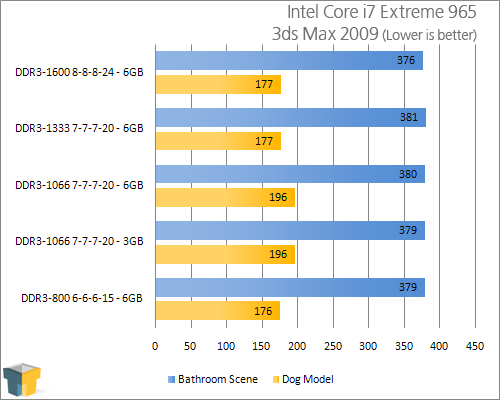
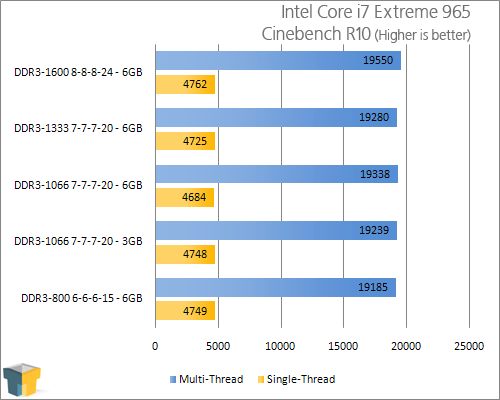
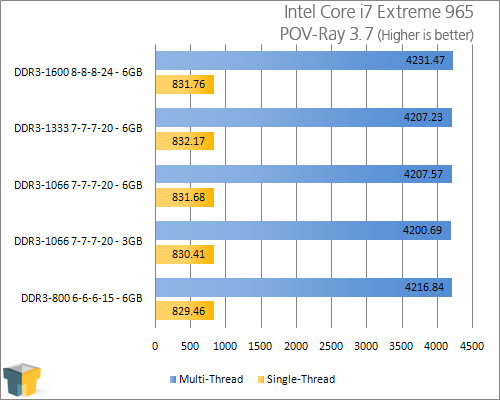
Our fast DDR3-1600 kit managed to take the top spot in all three of our rendering benchmarks, but the overall improvements are minimal at best. All of the increases seen were between 1% – 1.5%, which isn’t going to add up to much in the real-world, unless you are dealing with jobs that can take a few days. Even then, the differences are going to be an minutes, not hours.
Video Encoding & Image Manipulation
We know now that 3D designers aren’t going to see major improvements with faster memory, but how about the video gurus? Our three tests below had the job of finding out, and again, the differences we found were absolutely minute, although they were a bit better than what we saw above.
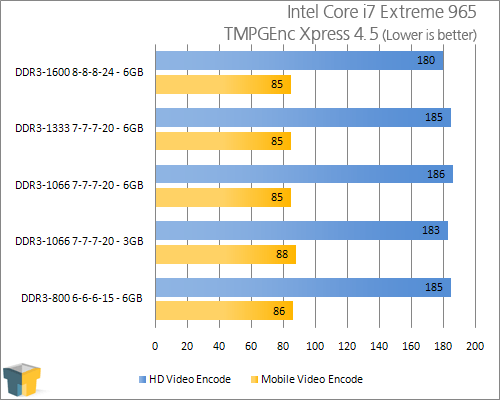
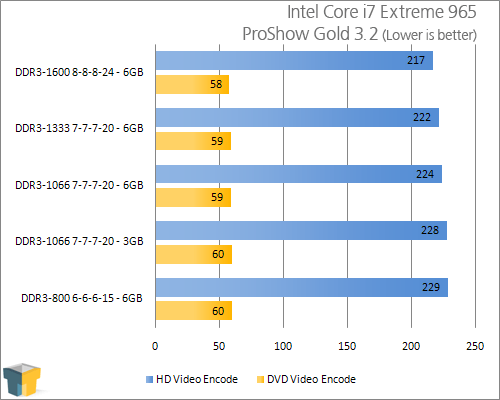
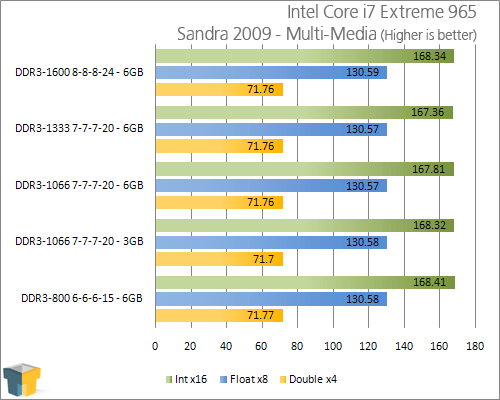
The test that showed off the biggest increase was ProShow Gold, which actually scales with RAM speed… something I wasn’t expecting. With small projects, like our DVD encode, the increases are incredibly small, but with larger projects, like our HD Video Encode, the real differences begin to be seen. The real gain in a scenario like this would be small, but things would change if you are dealing with much more elaborate jobs. I think it’s safe to say that overall, there are no notable performance gains so far.
On the next page, we’ll continue our run of benchmarks to see if we can see real gains anywhere.
Support our efforts! With ad revenue at an all-time low for written websites, we're relying more than ever on reader support to help us continue putting so much effort into this type of content. You can support us by becoming a Patron, or by using our Amazon shopping affiliate links listed through our articles. Thanks for your support!





